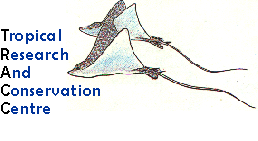|
|
|
|
Blast fishing frequency
|
 |
|
|
|
|
Underwater blasts are commonly heard at almost all dive sites within Sabah. In Mabul, close to Sipadan, there is a police post and two dive resorts yet blast fishing was heard underwater up to 15x per hour with a normal background level of 2-3 blasts per hour. This blasting rate was common at most locations sampled (see figure at right). |
Frequency of blasts from bomb fishing recorded per hour. Diver recorded sites: Sipadan, Mabul, Ligitan, Silam, Kunak, Kudat. Each site was studied for a minimum of ten hours during daylight hours. Data modified from Pilcher & Oakley (1997). Hydrophone recorded sites: Labuan, Mantanani; minimum of 10 hours during the morning from 0700-1200 (Oakley, 1999).
|
|
Deeper blasts at 8-12m or blasts positioned under a coral head create very little disturbance to the surface of the water and make no sound in the air so while the sound is very loud underwater the blasts are hard to detect from above. |
|
|
Obviously blast fishing detection and regulation is not the whole answer for sustainable use of fish reef resources. When the fishers cannot catch fish with sustainable methods, no amount of incentives or regulation will stop them using whatever methods are available to catch food for their families.
Many scientists and resource managers believe that to reduce blast fishing we have to find alternative income sources that are generally applicable to coastal communities.
|
|
|
A brief consideration of the alternatives rapidly eliminates many possible income sources as being too localised to be applicable to a circum- tropical problem.
|
|
|
Specialist aquaculture such as clams or sea horses are a part of the answer since they do appear to offer a localised affordable solution. Seaweed culture has developed in Sabah as an alternative to full time fishing but with requirements for calm, protected areas, this is not suitable for many locations.
The Fisheries Department Sabah has come up with an Aquaculture master plan which will guide some of these developments but there is no structural plan to improve enforcement of the Fisheries Laws. The general lack of funds, staff and facilities for enforcement, coupled with the lack of knowledge and awareness combined with the shortage of political will at all levels, means that the destruction will continue for the foreseeable future
|
|BLAST FISHING| |BLAST FISHING FREQUENCY| |ECONOMICS| |BLAST FISHING REGULATIONS| |EFFECTS ON BIODIVERSITY|
|EFFECTS ON CORAL REEFS| |ECOTOURISM PROTECTION|

![]()